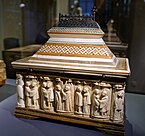Template:Did you know nominations/Embriachi workshop
<
Template:Did you know nominations
- The following is an archived discussion of the DYK nomination of the article below. Please do not modify this page. Subsequent comments should be made on the appropriate discussion page (such as this nomination's talk page, the article's talk page or Wikipedia talk:Did you know), unless there is consensus to re-open the discussion at this page. No further edits should be made to this page.
The result was: promoted by Aoidh (talk) 16:10, 23 January 2023 (UTC)
| DYK toolbox |
|---|
Embriachi workshop
- ... that around 1400, the Embriachi workshop in north Italy specialized in marriage caskets with carved bone plaques? Source: "Casket, date: c. 1390-c. 1410, Embriachi Workshop , Art Institute of Chicago
Moved to mainspace by Johnbod (talk). Self-nominated at 02:32, 16 January 2023 (UTC).
 New, long enough, neutral, and well cited. Earwig only flags cited quotes and titles, so no copyvio issues. Hook is appropriate length, cited in the text, and interesting. Image is free use, used in the article, and shows up at this size.
New, long enough, neutral, and well cited. Earwig only flags cited quotes and titles, so no copyvio issues. Hook is appropriate length, cited in the text, and interesting. Image is free use, used in the article, and shows up at this size. Just waiting for QPQ - ping me when that's done.QPQ done, now good to go. Pi.1415926535 (talk) 06:08, 16 January 2023 (UTC)- User:Pi.1415926535, thanks, qpq done (or ongoing with query). Johnbod (talk) 18:32, 17 January 2023 (UTC)
- @) 00:05, 19 January 2023 (UTC)
- Well, you haven't looked very hard! Ok, let's spoonfeed:
- that around 1400, the Embriachi workshop in north Italy - "Beginning in the 1370s, caskets like this, as well as private altarpieces, were manufactured in numbers at a workshop owned by a noble Florentine entrepreneur and diplomat, Baldassare degli Embriachi. After about 1395, the Embriachi family and its workshop moved operations to Venice where they continued to produce pieces into the second quarter of the fifteenth century."
- specialized in marriage caskets - "Given to noble or merchant-class brides in honor of a betrothal or wedding, small caskets such as this were used as keepsake boxes to house jewelry and other important mementos. The sides were often carved with emblematic scenes to entertain the recipient bride."
- with carved bone plaques? - "instead of costly ebony and ivory from Africa, the workshop’s craftsmen used common cow and horse bone, horn, and hooves. The carved segments on this casket partially retain the outer shape of the animal bones used."
- Johnbod Thank you for the message. Apologies, I should have stated the exact issue I had with the hook: I do not see a reference which states "... the Embriachi workshop in north Italy specialized in marriage caskets...". I am sure it is implied in the article but I cannot see a reference that states it. Bruxton (talk) 15:29, 19 January 2023 (UTC)
- Just checking back Johnbod. Bruxton (talk) 16:33, 21 January 2023 (UTC)
- Ok, thanks, that's clearer. I'll add the Barnes Foundation with "The workshops of the Embriachi family (active in Florence and Venice) mass-produced items carved in bone with wood and bone marquetry. In addition to altarpieces, they specialized in rectangular and polygonal caskets for holding documents or jewels, usually given as bridal gifts" to the article. Otherwise, "Fravolo", already used, says the same thing at greater length: "The characteristics of this casket connect it to the very particular production of the so-called “Embriachi” workshop, active in Venice in the early years of the 15th century. They also relate it to a type of object that played an essential role in married life during the Renaissance: marriage caskets. ... The caskets, hexagonal or rectangular, surmounted by a lid decorated in several registers and fitted with a metal handle ... constitute the secular, albeit equally renowned component of the workshop’s production, in addition to mirror frames and various everyday objects." I'll chuck in the Metropolitan "Although the Embriachi family primarily produced caskets decorated with tales from classical literature and medieval romances, a few very expensive altarpieces were commissioned for monastic foundations by prestigious donors...". Johnbod (talk) 17:15, 21 January 2023 (UTC)
- Just checking back Johnbod. Bruxton (talk) 16:33, 21 January 2023 (UTC)
- Johnbod Thank you for the message. Apologies, I should have stated the exact issue I had with the hook: I do not see a reference which states "... the Embriachi workshop in north Italy specialized in marriage caskets...". I am sure it is implied in the article but I cannot see a reference that states it. Bruxton (talk) 15:29, 19 January 2023 (UTC)

